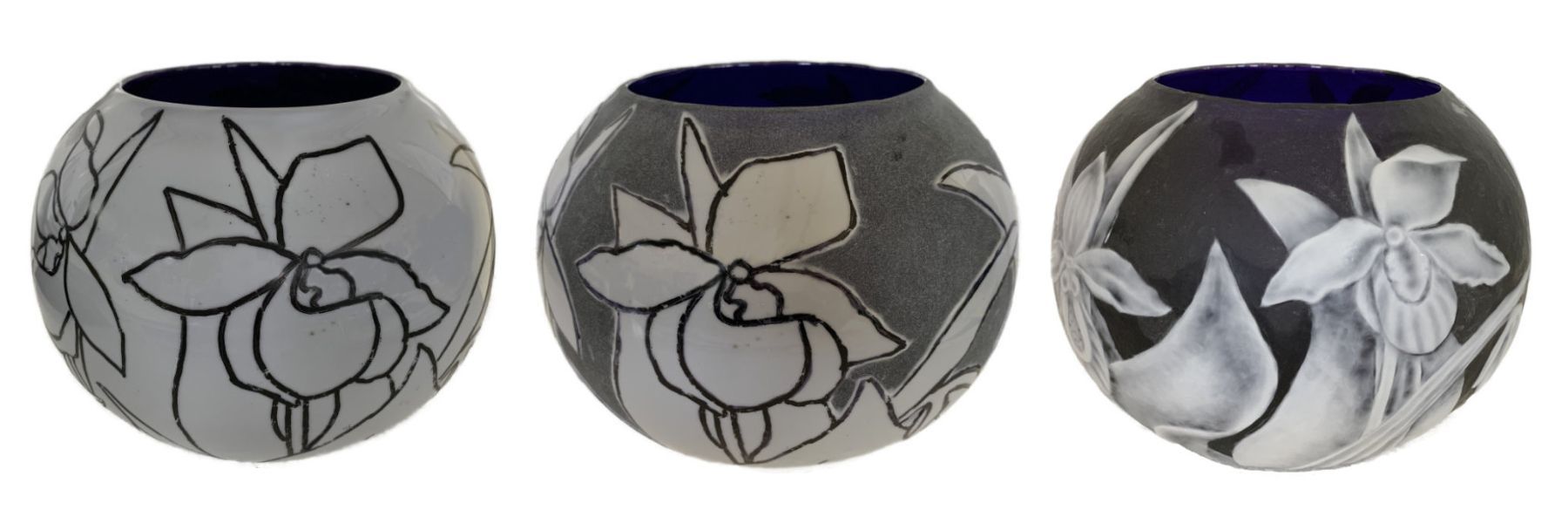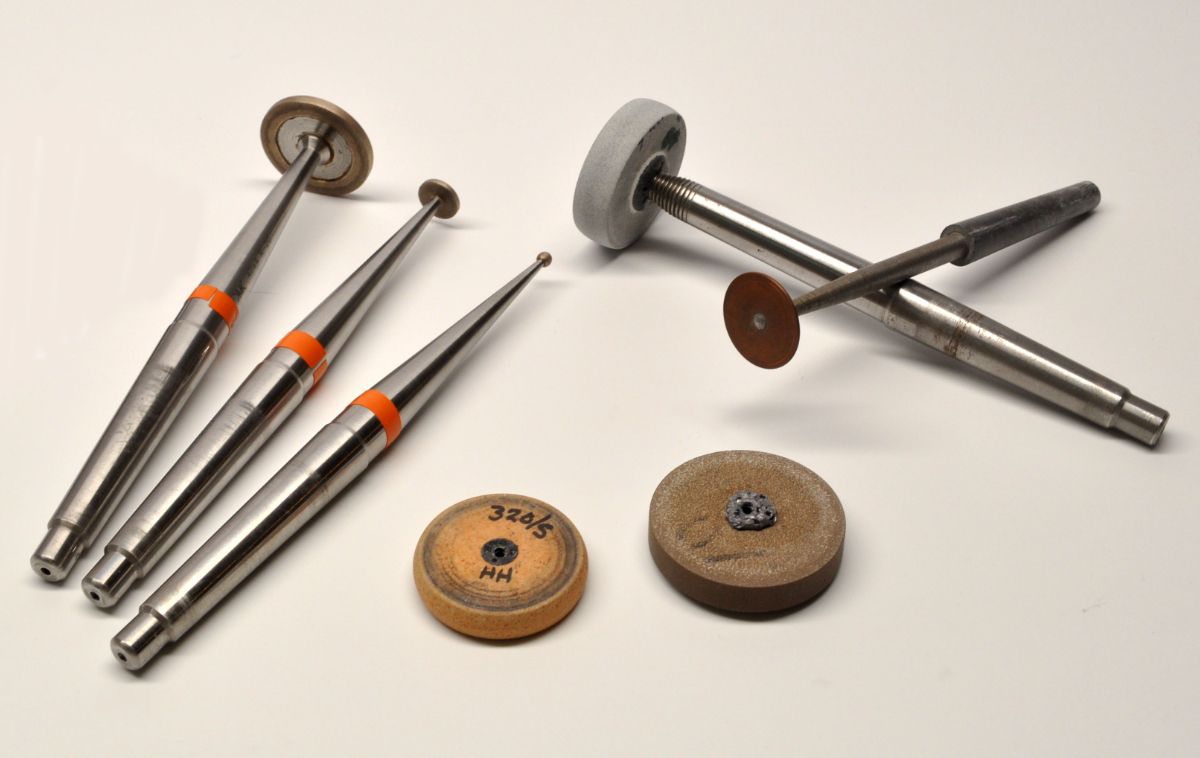ARTIST

PROCESS
An artist has many choices to consider on how best to express themselves in engraved glass. The design, glass, tools and technique all impact how the work will be perceived. Every artwork displayed in the portfolio required an intense process during which all these considerations were weighed. Some pieces were engraved on blanks created in the kiln, other blanks were blown by a talented gaffer, and another engraved on thinly layered hand blown sheet glass. A blank is what the glass object is called before the engraving process begins.
A cameo blank is created with one or more thin layers of color glass over a thicker base of color or clear glass. The artist engraves through a color layer, exposing some of the color below to develop the design. A relatable example would be your grandmother’s cameo brooch. Transparent color or clear glass blanks are engraved, either lightly to create a surface decoration, or deeper to give the illusion of volume in the design. Again, a relatable example would be a cut crystal wine glass. With a design and glass chosen, the artist then works to aesthetically arrange and engrave the design on the glass.
WHEEL ENGRAVING
Wheel engraving involves the use of many types of wheels, each attached to a spindle which is then rotated in a lathe. The glass is moved against the rotating wheel to create the design as glass is removed. Copper wheels are the traditional tool and engraving with them requires the most time, however the reward is a beautiful, silky smooth cut surface. A slurry of oil and grit applied to the copper wheel is what actually cuts the glass. Stone wheels are manufactured now by bonding grit into a matrix, and cut faster, but not quite as smoothly as copper. The grits used for both types of wheels are comparable to what is used to make sandpaper and available in similar grades or sizes. Copper and stone wheels are shaped by the artist to suit the need and both require a bit of maintenance to keep them cutting properly.

TOOLS
Diamond wheels are the latest on the scene. Diamonds of a uniform size are imbedded in hard metal, which is then cast to a specific size and shape. Once a diamond wheel has been made, it should retain its shape even as it gets smaller with use, requiring very little maintenance. These wheels cut the fastest and will leave a surface ranging from very scratchy to smooth, depending on the size of the diamonds. The artist may choose to use all three types of wheels to complete an engraved artwork.
Engraving is indeed a thoughtful process with many hours spent moving the glass against the wheel. It is also very intimate, meditative, and rewarding to watch the design come to life in your hands.
-
BIOGRAPHY
Heather has focused her practice on wheel engraved glass, and has been fortunate to study engraving with twelve internationally respected artists since 2005. She was an active member of Virginia Glass Guild 1994-2020, and received multiple awards of recognition from curators, prominent artists and gallery directors during the guild’s annual juried exhibitions. She was a demonstrating artist during the 2017 Glass Art Society Conference in Norfolk, and completed a one month artist in residence in Zelezny Brod, Czech Republic. After many years of visiting the area, Heather permanently moved to beautiful Whidbey Island in 2021, where she enjoys working in her new engraving studio with a view of the forest.
-
SALUTE TO MY ENGRAVING TEACHERS
2022 Greg Sullivan
2019 Jan Schindler
2017 Pavlina Cambalova
2016 Pietro and Riccardo Ferro
2016 Katharine Coleman
2015 Wilhelm Vernim
2015 Max Erlacher
2015 Fritz Dreisbach
2014 Fritz Dreisbach
2013 Katherine Coleman
2013 Max Erlacher
2012 Jiri Harcuba
2010 Alasdair Gordon
2009 Jiri Harcuba
2005 Michele Rinaldo
-
EXPERIENCE
2024 Classroom Equipment Preparation, The Studio at Corning Museum of Glass
2024 Cameo Glass A Studio Handbook, Fritz Dreisbach and Heather Hartle
2011-2020 Artist, Engraved Inspiration, Williamsburg, VA
2017 Demonstrating Artist, 2017 GAS Conference, Norfolk, VA
2017 Fabrication, Capturing Light by Charlotte Potter
2016 Fabrication, Lenticular America by Charlotte Potter
2015 Fabricaiton, Through Bloodlines and Timelines, Exhibition by Charlotte Potter, Heller Gallery, New York City
2014 Fabrication, Family Tree, by Charlotte Potter, Lorrie M. Saunders Art Gallery
2014 Fabrication, Pending, by Charlotte Potter, Visual Arts Center, Tidewater Community College, Portsmouth, VA
2012 Fabrication, The Weight of Lost Friendship, by Charlotte Potter, Claire Oliver Gallery
2012 Fabrication, Charlotte’s Web, by Charlotte Potter, Oklahoma City Museum of Art and Chrysler Museum of Art, Norfolk, VA
2005-2011 Artist, Cristallo Artisans, Newport News, VA
1999-2005 Partner, Cristallo Art and Glass Studio, Williamsburg, VA
1993-1999 Commission Stained Glass Artist, Self-employed
-
DEMONSTRATION VIDEO
This Live Demo was recorded during the June 2024 Engraving Imagery class I taught at The Studio at Corning Museum of Glass.
https://youtu.be/0Y66P6poKVw?si=PhXW_iubX25zwwu1



